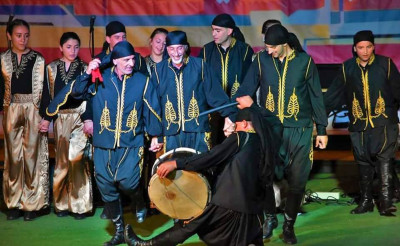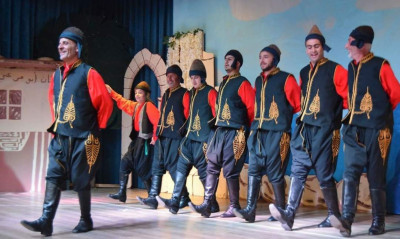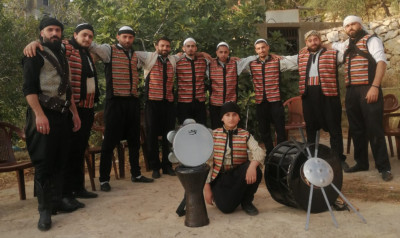The Lebanese Dabkeh
 Dabkeh (in Arabic: دبکة, which translates to “kick”) is a type of dance popular in Lebanon and neighboring countries. It’s a group line dance in which the dancers hold hands and rhythmically strike the floor. The leader of the dabkeh, called ras (meaning “head” in Arabic) leads the dance and the other dancers. He is allowed to improvise his dance. He holds a necklace of beads called masbaha or a handkerchief in his hand and spins it in the air while the other dancers maintain the rhythm. The dancers sometimes shout to add energy and emphasis to the dance. This chain dance symbolizes fraternity and solidarity. Dabkeh is most often danced at weddings, banquets, and occasional parties.
Dabkeh (in Arabic: دبکة, which translates to “kick”) is a type of dance popular in Lebanon and neighboring countries. It’s a group line dance in which the dancers hold hands and rhythmically strike the floor. The leader of the dabkeh, called ras (meaning “head” in Arabic) leads the dance and the other dancers. He is allowed to improvise his dance. He holds a necklace of beads called masbaha or a handkerchief in his hand and spins it in the air while the other dancers maintain the rhythm. The dancers sometimes shout to add energy and emphasis to the dance. This chain dance symbolizes fraternity and solidarity. Dabkeh is most often danced at weddings, banquets, and occasional parties.
 Dabkeh originated in rural areas where houses were built out of stone. Roofs made of mud and straw needed constant tamping to seal cracks caused by the changing seasons. Each homeowner would call on his neighbors for help (‘awneh). Lined up and holding hands, they would advance onto the roof, trampling the mud while shouting. In doing so, the men improvised a trampling pattern that they would all follow. With the introduction of the stone roller (mahdaleh), the dabkeh lost its primary function but remained as a dance accompanied by the music of several traditional instruments such as the mejwiz (double recorder), the derbouka, the daf (tambourine), and the nay (single-reed flute). It is danced in a number of different regional variations: Baalbakieh, Hendéniyeh (in reference to Ehden), Badawiyeh, Bcharnieh, Jnoubieh…
Dabkeh originated in rural areas where houses were built out of stone. Roofs made of mud and straw needed constant tamping to seal cracks caused by the changing seasons. Each homeowner would call on his neighbors for help (‘awneh). Lined up and holding hands, they would advance onto the roof, trampling the mud while shouting. In doing so, the men improvised a trampling pattern that they would all follow. With the introduction of the stone roller (mahdaleh), the dabkeh lost its primary function but remained as a dance accompanied by the music of several traditional instruments such as the mejwiz (double recorder), the derbouka, the daf (tambourine), and the nay (single-reed flute). It is danced in a number of different regional variations: Baalbakieh, Hendéniyeh (in reference to Ehden), Badawiyeh, Bcharnieh, Jnoubieh…
 Despite folklorization efforts in the 1950s, dabkeh types have remained the same. Following the launch of the Baalback International Festival in 1956, a Soviet expert in popular dance, Igor Moiseyev, was asked to make an assessment of Lebanese folklore, particularly dance. He noted the degradation of this dance and proposed a choreography featuring different styles that could represent all Lebanese performances. He also proposed that professional Lebanese dancers go to the USSR to learn the principles of folk dance and the methods to teach them. The Baalbek Festival Folklore Committee adopted the recommendations of Igor Moiseyev’s report and sent Wadih and Randa Jarrar, who had trained the troupe that had performed with the Rahbani brothers and Fairouz in Baalbek. “This apprenticeship at Moiseyev’s school led to the formation of numerous folk dance troupes and the reopening of closed wells” (Munassa 1994: 13). Folklorization, however, took a popular mode of expression away from its original communities and placed it in the hands of a social elite who purified it of its local and confessional components and transformed it into a modern artistic performance representing the whole of Lebanon: a dabkeh lubnanieh.
Despite folklorization efforts in the 1950s, dabkeh types have remained the same. Following the launch of the Baalback International Festival in 1956, a Soviet expert in popular dance, Igor Moiseyev, was asked to make an assessment of Lebanese folklore, particularly dance. He noted the degradation of this dance and proposed a choreography featuring different styles that could represent all Lebanese performances. He also proposed that professional Lebanese dancers go to the USSR to learn the principles of folk dance and the methods to teach them. The Baalbek Festival Folklore Committee adopted the recommendations of Igor Moiseyev’s report and sent Wadih and Randa Jarrar, who had trained the troupe that had performed with the Rahbani brothers and Fairouz in Baalbek. “This apprenticeship at Moiseyev’s school led to the formation of numerous folk dance troupes and the reopening of closed wells” (Munassa 1994: 13). Folklorization, however, took a popular mode of expression away from its original communities and placed it in the hands of a social elite who purified it of its local and confessional components and transformed it into a modern artistic performance representing the whole of Lebanon: a dabkeh lubnanieh.
The civil war (1975-1990) and the freezing of the activities of the Baalback Festival reduced the number of national folk troupes or turned them towards modern performances drawing on a variety of choreographic registers. All these factors have contributed to the reappearance of dabkeh in local communities. It is still considered a lubnanieh dabkeh, but it is also defined as a local variant.

